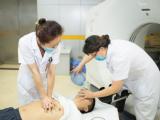Sep 9, 2005 (CIDRAP News) – The nation's system for stopping dangerous microbes at its ports of entry needs to be strengthened through increased leadership and planning and improved communications, the Institute of Medicine (IOM) has concluded.
The Centers for Disease Control and Prevention (CDC) and its Division of Global Migration and Quarantine (DGMQ) must have the responsibility, authority, and resources to lead the effort to protect the public from microbial threats, the IOM said in a Sep 1 announcement about the release of its report on the quarantine system.
The report, requested and paid for by the CDC, calls for updating quarantine practices, from specifying leadership roles and lines of authority to altering practices based on more scientific measurements of results.
The report comes amid sweeping changes in CDC's quarantine network, which is expanding from eight stations in 2003 to 17 stations this year and will grow to 25 next year, said CDC spokeswoman Jennifer Morcone.
Marty Cetron, MD, director of the DGMQ, which is part of the coordinating center for infectious disease, said he was extremely pleased with the report. Staff had been awaiting the report, which he said will provide a jumping-off point for a planning process.
"They're [the IOM committee members are] on target with the direction we've been moving," Cetron said, adding that the IOM's nine-member committee laid out a fairly ambitious agenda.
The IOM said the United States once had 55 federal quarantine stations, but the perception that microbial threats had been controlled led to dismantling of most of the system in the 1970s. However, nearly 40 new infectious diseases have been identified since 1973, and bioterrorism has become a serious concern.
The 25 stations that will make up the expanded quarantine station system now receive more than 75 million international travelers a year, the IOM said. The stations screen travelers, refugees, immigrants, animals, and cargo for disease agents shortly before and during their arrival. However, the quarantine system relies on a much broader network that includes local public health agencies, hospitals, customs agents, agricultural inspectors, and others, the IOM said.
The IOM is recommending the following:
- The quarantine stations, the CDC, and the DGMQ (called the quarantine core) should lead the effort by developing a national strategic plan with uniform principles and outcomes. The quarantine core should shift its main focus from inspecting people and cargo at ports to leading the activities of the overall quarantine system. The strategic plan should help participating government agencies and other groups in the system to prioritize activities and focus resources on the greatest risks.
- The quarantine core should work with partners in the quarantine network to define or redefine each group's roles, authority, and communication channels.
- The quarantine system needs enhanced skills, more people, more training, more space, and better use of technology to fulfill its evolving role. An example of technology cited in the news release was targeted use of passenger locator cards that could be used on flights to and from countries with disease outbreaks. The cards would log passenger seat numbers and contact information in a scannable format. This could simplify tracking of passengers potentially exposed to disease, such as those who flew to the United States from Sierra Leone in 2004 with a man who later died of Lassa fever.
- The quarantine core must review its methodology periodically to ensure stations are in the best places and appropriately staffed.
- The quarantine core must have plans, capacity, resources, and "clear and sufficient legal authority" to respond quickly to surges in activity at one or more ports.
- The core must define and fund a research agenda to measure the effectiveness of its procedures. The committee found that many routines at quarantine stations are based on experience and tradition and lack a scientific basis.
- The core must use scientifically sound methods to measure the effectiveness and quality of its operations, including assessing performance of critical functions throughout the system. It must also address any shortfalls that come to light.
"CDC quarantine stations and the broader quarantine system serve as the nation's insurance policy against catastrophes that might arise from the importation of naturally occurring infectious agents, such as the SARS virus, or man-made threats like an attack using a dangerous biological agent," Georges Benjamin, executive director of the American Public Health Association and chairman of the committee that wrote the report, stated in the news release. "But no single entity currently has the responsibility, authority and resources to orchestrate all the activities of the quarantine system and the traditional responsibilities of quarantine personnel are no longer sufficient to meet the challenges posed by the rapidly increasing pace of global trade and travel and the emergence of new microbial threats."
There is still a place for quarantine workers' traditional function of moving sick people off airplanes, but the duties are much broader and more complex today, Benjamin said in a phone interview yesterday. "CDC needs to step back from being a primary doer to being more strategic," he said.
No one should expect the quarantine stations to keep all diseases out, Benjamin added. While the task is almost overwhelming for such a small group, "we don't think they should go away." They should expand but take this opportunity to evolve quickly and with flexibility, he said.
The CDC's Cetron said the agency has already begun building collaborations and linkages, but added that the agency must lead by consensus.
The CDC will use the report to move forward as it figures out the price tag for such an ambitious project and which pieces to prioritize. The report calls for a "more robust investment" than has been made to date, Cetron said.
The cost of failure could be higher. "We're moving people around the globe and around states who have clear health needs," without having the ability to track them, he said.
See also
Full IOM report online
http://www.nap.edu/books/030909951X/html/
Oct 6, 2004, CIDRAP News story on man who entered US with Lassa fever


















